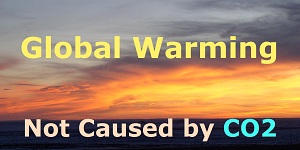| ||||||||||||||||||||||||||||
|
Gary Novak
The Cause of Ice Ages and Present Climate |
Recent Conclusions January 2013 The past thirty years show a cycle which is similar to one which occurred eighty years earlier. These cycles appear to be false starts for the beginning of the next ice age. To start the next ice age, there has to be more snow falling in the north than can melt during the summers. Then sunlight gets reflected away creating a precipitous cool-down. There isn't that much precipitation yet. It looks like another 200-400 years will be required for precipitation to get to that level. The false starts are characterized by a melting of Arctic ice. The Arctic was open early in the twentieth century and again late in the twentieth century. Arctic ice melts when warm Pacific Ocean water flows over the Bering Strait, across the north pole and back out into the Atlantic near Greenland. This was occurring during the 1980s and 90s. Alaska was greatly warmed, at least near the coastal areas, by the warm water flowing by. Over the past few years, the Bering Strait froze back up, and the temperature of coastal Alaska has gotten extremely cold. The warm Pacific Ocean water also caused precipitation to greatly increase over the northern United States. During the 80s and 90s, The northern plains were producing corn and soybeans, where there is usually grasslands and wheat. The past four years indicate a trend of colder and drier conditions in the northern plains. In fact, an extreme drought during 2012 is strikingly similar to the drought of the thirties. The timing is also similar—which is about thirty years after Arctic ice melted. One year of drought is too soon to draw conclusions, but there could be several years of drought similar to the thirties. It appears that the Pacific Ocean cools back down after each warm-up, which reduces precipitation over the U.S. In terms of long trends, the oceans continually warm up, and only the large ice sheet of an ice age cools them back down. Heat accumulates in the oceans much more significantly than on land. Ocean heat has two major sources. One is geothermal heat which constantly moves from the center of the earth outward. As it moves outward, the continental plates get thicker. The other source is solar energy. Solar radiation does not penetrate very far on land, which allows most of it to escape during the nights. But oceans absorb solar energy to a depth of 30 feet (10 meters). This amount of depth causes heat to accumulate in the oceans much more than on land. This means the oceans will continue to heat up until the next ice age occurs. Ice ages have been occurring very precisely at 100 thousand year intervals. The next one is scheduled to begin any time. But there will need to be more precipitation in the air, which will require the Pacific Ocean to heat up to a warmer temperature than it has been recently.
|
||||||||
 | |||||||||

